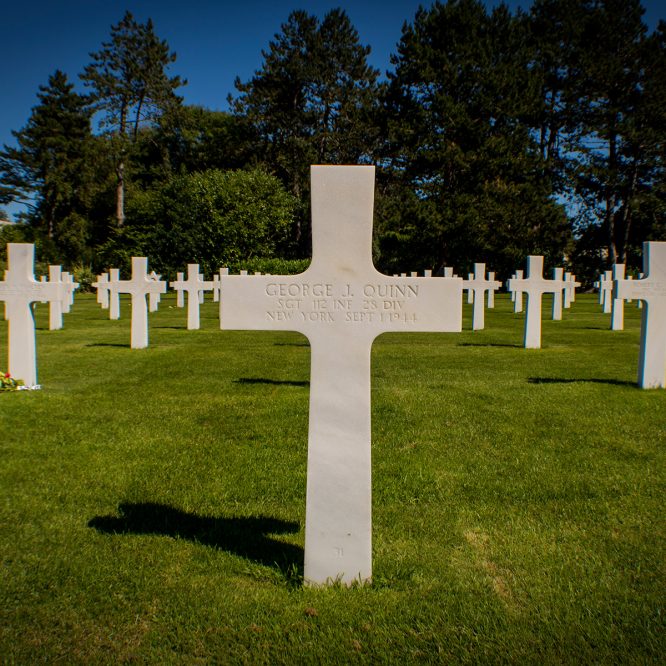Volume 3, Issue 34
Over the summer I had the honor and privilege of visiting the Normandy American Cemetery at Colleville-sur-Mer, France. Dedicated in 1956, the cemetery encompasses 172.5 acres and serves as a final resting place for over 9,000 soldiers killed in action in Europe. Although the site was primarily used to bury those killed during the Normandy Breakout, many families requested that Normandy serve as the place of eternal rest for their deceased veterans regardless of where they were killed.
Wandering the sprawling fields lined with white crosses reveals ornately decorated stones etched in gold leaf, denoting the graves of men who received the Congressional Medal of Honor. One stone melds into the thousands of plainly lettered marble crosses, the stone of Sgt. George J. Quinn.
Born at Buffalo, NY on September 5, 1924, Quinn spent most of his life growing up in the vicinity of North Ridgeway. After graduating from Barker, he spent a short period of time working for Harrison Radiator in Lockport before he was inducted into service in March of 1943. Basic training at Ft. Leonard Wood, Missouri and Camp Pickett, Virginia was followed by deployment to England in October of 1943.
On June 6, 1944, Allied forces stormed the beaches of Normandy in an effort to establish a foothold in France, resulting in the deaths of over 4,000 men. The capture of Utah, Omaha, Gold, Juno, and Sword beaches did not mark the end of the Normandy operation, as troops continued to push through the thick hedgerows of the bocage. On July 22, 1944, Sgt. Quinn and the 112th Infantry landed at Normandy and began the process of breaking out of St. Lo.
The timeline of events during the months of July and August suggest that Quinn was wounded while fighting in the bocage on August 7th, to which he was awarded the Purple Heart. On August 28, 1944, the 112th Infantry along with the remainder of 28th Division arrived in Paris, greeted by crowds of onlookers who welcomed their liberators with cheerfulness and relief. The following day the division marched up Avenue Hoche to the Arc de Triomphe and down the Champs Elysees as they progressed north towards their next objective.
On September 1, 1944, the 112th Infantry travelled by truck to Compiegne where the men were again greeted by the newly liberated French. After enjoying a meal of coffee, biscuits, and other local delicacies, Sgt. Quinn and his unit progressed towards a wooded area north of the town. At 7:30am, segments of the 112th were met by heavy resistance from German soldiers camped around the outskirts of Compiegne. Finally, at 11:15am, the unit was able to progress further north, but not without suffering a number of casualties.
George Quinn, only four days shy of his 20th birthday, was killed in action while pushing through these woods. His body was interred at the Normandy American Cemetery, among the thousands of others who sacrificed their lives for the liberation of France and the European continent.


